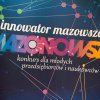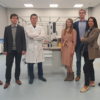
Research and development works to develop a MULTISENSOR prototype – an innovative micro-sensor for identifying bacterial or viral causes of upper respiratory tract infections” as part of action 1.1 “Enterprise R&D projects” sub-action 1.1.1 “Industrial research and development activities carried out by enterprises” of the Smart Growth Operational Programme 2014-2020, co-financed by the funds from the European Regional Development Fund
Project implementation progress
In the Multisensor project’s first stage, specific and conserved amino acid sequences were selected from proteins constituting specific biomarkers of selected respiratory pathogens. From a pool of nine biomarkers, those with the highest level of overproduction were selected. After purification, five recombinant proteins – one for each pathogen and a control protein – were obtained, which were transferred from the processing in the second stage of the project.
As a result of the second stage, we obtained the three most efficient bioreceptor sequences in industrial-scale production for each biomarker derived from influenza B, S. pyogenes, Rhinovirus, and H. Influenzae pathogens. Under the contract with the subcontractor, two monoclonal antibodies were obtained for each selected biomarker derived from the pathogens, as mentioned earlier with high specificity, confirmed by the ELISA technique. As mentioned earlier, a database of specific bioreceptors for the pathogens was obtained, which became the starting point for research in the third stage. In the third stage, we have developed electrodes to detect influenza B, S. pyogenes, Rhinovirus, and H. Influenzae pathogens. Moreover, the electrodes have been optimized in terms of their manufacturing costs. We assessed the electrodes’ sensitivity in comparison to reference methods using real-time PCR techniques and microbiological cultures. Based on simultaneous research on detecting the pathogens mentioned earlier on electrodes and using molecular techniques, we have shown that our method is 95% sensitive to the gold standard (real-time PCR).
We have developed the design, hardware, and firmware of the device used to collect the initial results. The design is pleasing to the eye and has a professional appearance. The materials used in its construction have been selected for their biocompatibility. The hardware of the device has been chosen in such a way as to be able to quickly and precisely analyze the data from the electrodes while minimizing it. A special algorithm has been developed for the device, which aggregates the reader’s data and processes them following the built-in decision-making system based on previously obtained in vitro results. The algorithm is built into a specially created application that enables data presentation to the monitor screen user. The application for use has been written for the Windows environment and meets the requirements necessary for proper operation in this environment.










